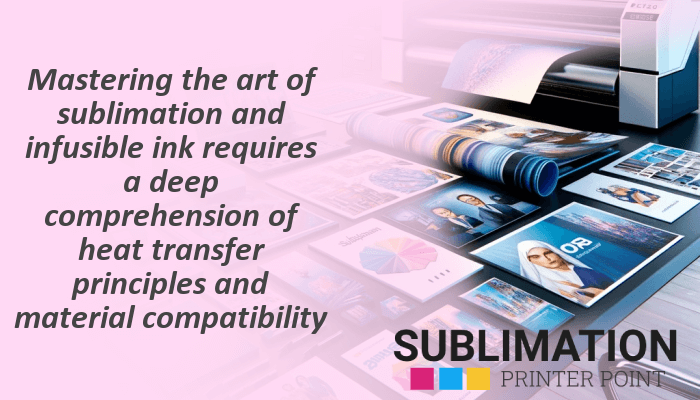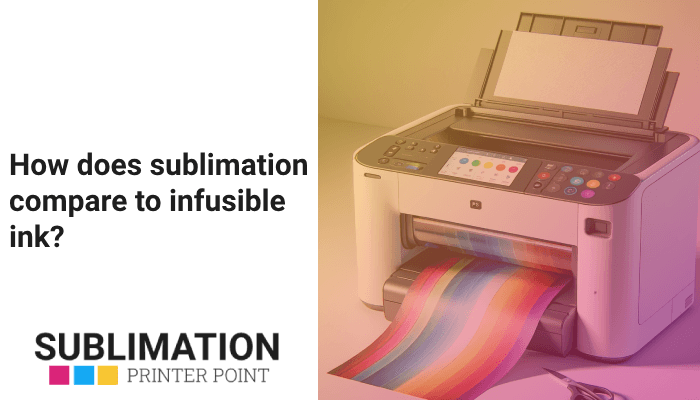Two popular printing methods that are gaining popularity in the business are sublimation and infusible ink. Discover the scientific underpinnings of these techniques, what tools are required, and which materials work best for each procedure.
Sublimation and infusible ink are printing processes that use heat to transfer graphics to various substrates. Sublimation is the process of turning solid dye particles into gas, and it works best with materials made of polyester or products that have been properly treated. A Cricut product called infusible ink allows you to imprint designs into materials with brilliant, long-lasting, and peel-proof results. Both techniques call for specialized equipment, including a heat source and a sublimation printer or sheets and pens with infusible ink. The specifications and intended result of the project will determine whether sublimation or infusible ink is used.
- Sublimation uses heat to change solid dye particles into gas, imprinting the design onto the substrate.
- Infusible ink, a heat transfer method, embeds the design into the material for a seamless finish.
- Both techniques require specific tools and materials, with sublimation favoring polyester-based or specially coated items, and infusible ink working best with Cricut’s range of compatible blanks.
- The choice between the two methods depends on the project’s requirements and the desired outcome.
| Process | Key Components | Materials Used | Practical Applications |
|---|---|---|---|
| Sublimation | Sublimation printer, sublimation ink, sublimation paper, heat press | Polyester-based materials or specially coated substrates | Personalized clothing, home decor, promotional items |
| Infusible Ink | Infusible ink pens or sheets, compatible material (blank), heat source (Cricut EasyPress) | Cricut’s range of compatible blanks | Personalized t-shirts, tote bags, coasters, home decor items |
The main elements, materials utilized, and useful applications of the sublimation and infusible ink processes are compared in this table.
What is the basic understanding of sublimation and infusible ink?
In the world of printing, sublimation and infusible ink are two different techniques, each with special qualities and uses. Heat is used in the sublimation technique to imprint the design into the substrate by turning solid dye particles into a gas without first going through a liquid phase. Conversely, Cricut’s infusible ink is a form of heat transfer that does more than just print on a material; it actually embeds the pattern into it. Bright, long-lasting, and peel-proof designs are the end result of this. Both approaches are widely used to create personalized products, like as apparel and home décor, and it’s important to know how they differ in order to select the best way for the job at hand.
What is the sublimation process?
A substance can sublimate—a remarkable scientific phenomenon—by going straight from the solid to the gas phase without first passing through the liquid stage. This procedure is used in printing to produce vivid, long-lasting prints. Using a specialized sublimation printer and ink, the design is first printed onto sublimation paper. The ink becomes a gas and seeps into the substrate’s fibers when heat is applied; the substrate is usually made of polyester. The end product is a durable, high-quality print that won’t peel or fade with time.
What are infusible ink projects?
Crafts using Cricut’s Infusible Ink technology are known as edible ink creations. Using this technique, a pattern is made with infusible ink pens or sheets and heated to transfer it to a suitable surface. The infusible ink process, in contrast to conventional heat transfer techniques, embeds the ink into the material, producing a smooth, polished finish. Craft enthusiasts and business owners can choose from a wide variety of edible ink projects, such as personalized t-shirts, tote bags, coasters, and home decor items.
Unbeknownst to you, the word “sublimation” in printing comes from a scientific procedure in which a material changes directly from a solid to a gas without first passing through a liquid state. This is precisely what transpires when sublimation ink is heated to the point of becoming a gas and seeping into the substrate’s fibers.
What are the key components in sublimation and infusible ink processes?
A few essential elements are involved in both the sublimation and infusible ink processes, which all add to the finished product. A heat press, sublimation paper, ink, and a sublimation printer are necessary supplies for sublimation. In contrast, the infusible ink method needs a heat source, like a Cricut EasyPress, compatible material (referred to as a blank), and infusible ink pens or sheets. You can navigate the process and get the greatest results if you understand these elements and their functions.
What role does a sublimation printer play?
An essential component of the sublimation process is a sublimation printer. It is made especially to work with sublimation ink, which differs from regular ink in some ways. Sublimation paper is placed onto the substrate after the printer transfers the pattern on it. A vivid, long-lasting print is produced when heat is applied because the ink on the paper transforms into a gas and is absorbed by the substrate. Renowned brands such as Sawgrass and Epson are well-known for producing superior sublimation printers.
How are infusible ink pens and sheets used?
The technique of creating infusible ink requires pens and sheets. The sheets are pre-printed with a range of patterns and colors, and the pens let you write or draw your creations by hand. When your design is completed, it is applied with heat to the blank (the material on which you are transferring the design). The infusible ink turns into a gas when heated, and this gas penetrates the blank to create a vivid, long-lasting design that won’t peel or fade.
How does heat transfer apply to sublimation and infusible ink?
A key component of the infusible ink and sublimation processes is heat transmission. The process of sublimation involves heating ink over sublimation paper until it turns into a gas and permeates the substrate. The ink is made into a gas and embedded in the blank with the use of heat during the infusible ink process. Heat application is an essential phase in both processes, and the end product’s quality can be greatly impacted by the temperature and length of the heat application.
A helpful hint is to make sure your material or “blank” is compatible before using Cricut’s Infusible Ink. Cricut’s line of blanks, which are specifically made to absorb the ink and produce a smooth, polished finish, are the ideal match for Infusible Ink. Incompatible materials might produce less than ideal results.
What is the function of a heat press in sublimation?
An indispensable tool for sublimation is a heat press. It gives the sublimation ink the heat and pressure it needs to turn into a gas and penetrate the substrate. To get the best results, the heat press must heat up to a high temperature—typically about 385°—and hold that temperature steady for a predetermined amount of time. A professional finish with brilliant colors and a pattern that won’t fade or peel is ensured by using a heat press.
How does a cricut machine work with infusible ink?
A Cricut machine is an incredibly flexible instrument that can be used to cut a wide range of materials into elaborate designs, including sheets of infusible ink. When using infusible ink, the design is cut out of the sheet by the Cricut machine, and any extra material is weeded off before being placed to the blank. After that, the design is transferred to the blank using a heat press or Cricut EasyPress. Because of its accuracy and adaptability, the Cricut machine is a priceless resource for intricate and sophisticated infusible ink projects.
What are the differences in materials used for sublimation and infusible ink?
While brilliant, long-lasting prints can be produced using both sublimation and infusible ink techniques, their preferred materials vary. Polyester-based materials or substrates with specialized coatings are needed for sublimation since the ink must penetrate the material’s fibers. Contrarily, Cricut’s selection of compatible blanks, which are especially made to absorb the ink and produce a smooth, polished finish, are the ideal match for edible ink. Selecting the appropriate materials for your project might be facilitated by being aware of these variations.
What are sublimation blanks and how are they used?
Items that have undergone special processing or are composed of materials that may absorb sublimation ink are known as sublimation blanks. These can include rigid substrates like ceramic cups and metal sheets coated with a unique polymer coating, as well as textiles and apparel made of polyester. A sublimation printer is used to print the design onto sublimation paper, and a heat press is used to transfer the design onto the blank. The ink changes into a gas due to the heat, which is subsequently absorbed by the blank to produce a vivid, long-lasting print.
How are infusible ink blanks different?
Blanks for edible ink made specifically to be used with Cricut’s edible ink are known as edible ink blanks. These blanks have a smooth, polished appearance because they are composed of a substance that, when heated, may absorb the infusible ink. Items such as coasters, ceramic tiles, t-shirts, and tote bags can all be made with edible ink blanks. Using infusible ink pens or sheets, the design is made, and then it is transferred onto the blank with a heat press or Cricut EasyPress to create a brilliant, long-lasting design that won’t peel or fade.

What are the practical applications of sublimation and infusible ink?
There are many real-world uses for sublimation and infusible ink processes, especially when it comes to personalized and promotional goods. These techniques give an approach to produce designs that are vivid and long-lasting, suitable for a variety of applications, from apparel and home furnishings to promotional goods and presents. Realizing the useful uses for these techniques can lead to a plethora of opportunities, regardless of your interests—a hobbyist wanting to make unusual things for home or a business owner hoping to sell customized goods.
How are sublimation mugs and t-shirts made?
Using a sublimation printer to print a design onto sublimation paper, followed by a heat press to transfer the design onto the cup or t-shirt, is how sublimation mugs and t-shirts are manufactured. The ink turns into a gas due to the heat, and the mug’s unique coating or the polyester fibers of the t-shirt absorb the gas. The end product is a vivid, long-lasting print that remains intact even after several washings. Thanks to this technique, t-shirts and mugs with custom designs and vivid colors can be produced.
What can you create with infusible ink coasters and tote bags?
The creative possibilities with these infusible ink coasters and tote bags are almost endless. Even with frequent usage, you can create personalized coasters with detailed graphics and eye-catching colors that won’t fade or peel. Similarly, distinctive graphics can be added to infusible ink tote bags, which makes them ideal as a promotional or gift item. Using infusible ink pens or sheets, a design is made, and then it is transferred onto the coaster or tote bag using a heat press or Cricut EasyPress. As a result, the material has a colorful, long-lasting design that has a polished appearance.

